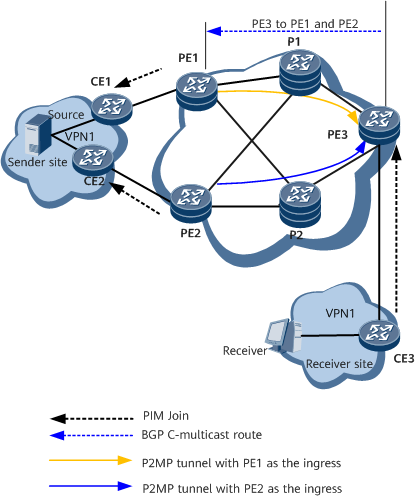Configuring Dual-Root 1+1 Protection
This section describes how to configure upstream multicast hop (UMH) route selection rules on receiver PEs on an NG MVPN, so that the receiver PEs can select the same sender PE as their root node during VPN route selection.
Usage Scenario
Pre-configuration Tasks
To use RSVP-TE P2MP tunnels:
Configure an NG MVPN.
Configure BFD for P2MP TE on the root nodes.
Configure VPN FRR on leaf nodes.
Enable BFD globally on the root and leaf nodes.
To use mLDP P2MP tunnels:
Configure an NG MVPN.
Configure BFD for mLDP P2MP on the root and leaf nodes.
Configure VPN FRR on leaf nodes.
Enable BFD globally on the root and leaf nodes.
Configure an NG MVPN.
Configure VPN FRR on leaf nodes.
Perform the following steps on the leaf nodes:
Procedure
- Run system-view
The system view is displayed.
- Run ip vpn-instance vpn-instance-name
The VPN instance view is displayed.
- Run ipv6-family
The VPN instance IPv6 address family view is displayed.
- Run mvpn command
The VPN instance IPv6 address family MVPN view is displayed.
- Run c-multicast frr
C-multicast FRR is enabled.
- (Only for the flow detection-based configuration) Run c-multicast frr flow-detection-based
Flow detection-based C-multicast FRR is configured.
- (Optional) Run multicast wtr wtr-time
A switchback wait time is configured for C-multicast FRR in NG MVPN 1+1 protection scenarios.
- Run commit
The configuration is committed.
Verifying the Configuration
After configuring dual-root 1+1 protection, check the configurations.
Run the display pim ipv6 [ vpn-instance vpn-instance-name | all-instance ] routing-table [ group-address [ mask { group-mask-length | group-mask } ] | source-address [ mask { source-mask-length | source-mask } ] | incoming-interface { interface-type interface-number | register | through-bgp } | outgoing-interface { include | exclude | match } { interface-type interface-number | register | none | pseudo } | mode { ssm | sm } | flags flag-value | fsm ] * [ outgoing-interface-number [ number ] ] command to check information about the IPv6 PIM routing table.
# Run the display pim ipv6 [ vpn-instance vpn-instance-name | all-instance ] routing-table command. The command output shows backup PIM entries in the IPv6 PIM routing table.
